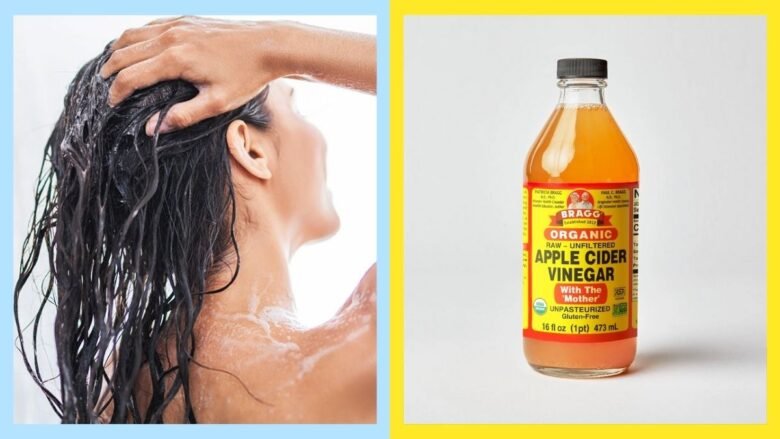Apple cider vinegar (ACV) is a powerhouse ingredient with countless benefits for the body, but did you know it can work wonders for your hair as well? If you’re looking for a natural, cost-effective way to achieve shiny, healthy, and manageable hair, an ACV hair rinse is the answer. Packed with acetic acid, vitamins, and minerals, apple cider vinegar helps balance the scalp’s pH, remove product buildup, and boost shine while enhancing the overall health of your hair.
In this guide, we’ll walk you through how to create and use an apple cider vinegar hair rinse, the benefits of incorporating it into your hair care routine, and tips for making the most out of this DIY hair treatment.
Why Apple Cider Vinegar Is Good for Your Hair
Before diving into how to create an apple cider vinegar rinse, let’s first take a look at the benefits of ACV for your hair.
1. Restores Scalp pH Balance
Your scalp, like your skin, has a natural pH that helps it function properly. A typical scalp pH is between 4.5 and 5.5, which is slightly acidic. Many shampoos, conditioners, and styling products are often too alkaline, disrupting the scalp’s natural acidity and leading to dryness, flakiness, or irritation. Apple cider vinegar, with its acidity, helps restore the scalp’s natural pH balance, promoting a healthy environment for hair growth and reducing issues like dandruff and itchiness.
2. Adds Shine and Softness
ACV helps smooth down the hair cuticle, the outermost layer of your hair strands. When the cuticle lies flat, your hair reflects more light, making it look shinier and healthier. Additionally, this process reduces frizz, leaving your hair feeling softer and more manageable.
3. Removes Product Buildup
Over time, styling products, hairsprays, and even shampoos can leave a residue on your hair and scalp, making it dull, weighed down, and less responsive to other hair treatments. Apple cider vinegar works as a natural clarifier, breaking down product buildup and impurities, allowing your hair to breathe and shine once more.
4. Improves Hair Strength and Elasticity
ACV contains alpha-hydroxy acids (AHAs) that gently exfoliate the scalp, encouraging healthy cell turnover and improving hair texture. The nutrients in ACV, like vitamins B and C, strengthen hair, making it less prone to breakage, split ends, and dryness.
5. Fights Dandruff
The antifungal and antibacterial properties of apple cider vinegar help reduce dandruff and flakes by clearing up the scalp, preventing the growth of harmful bacteria or fungi that may contribute to flakiness.
How to Create an Apple Cider Vinegar Hair Rinse
Now that you understand the incredible benefits of ACV for your hair, let’s talk about how to create an effective and easy apple cider vinegar hair rinse. The process is simple and can be done in just a few minutes.
Ingredients You’ll Need:
- 1 to 2 tablespoons of raw, unfiltered apple cider vinegar (preferably with “the mother” for maximum benefits)
- 1 cup of warm water (you can adjust the amount depending on hair length)
- Optional ingredients for added benefits:
- A few drops of essential oils (such as lavender, peppermint, or tea tree oil)
- Honey (for added moisture, especially if you have dry hair)
- Aloe vera gel (for soothing the scalp and adding extra hydration)
Instructions:
Step 1: Mix the ACV Rinse
- Start by measuring out 1 to 2 tablespoons of raw, unfiltered apple cider vinegar. If you have shorter hair or a sensitive scalp, start with 1 tablespoon. For longer or thicker hair, 2 tablespoons will provide a deeper cleanse.
- Dilute the vinegar with 1 cup of warm water. The water should be warm, but not too hot, as excessive heat can destroy the beneficial enzymes in the vinegar.
- (Optional) Add a few drops of essential oils for an aromatic boost and extra benefits. Lavender or peppermint oil can soothe the scalp, while tea tree oil has antibacterial properties that help reduce dandruff.
- (Optional) If you have dry hair, you can mix in 1 teaspoon of honey or 1 tablespoon of aloe vera gel to keep your hair hydrated and soft.
Step 2: Prepare Your Hair
- Wash your hair with your regular shampoo. You want to clean your hair first before applying the ACV rinse, so it can work more effectively to remove any buildup.
- After shampooing, rinse your hair thoroughly with water to remove any residual shampoo.
Step 3: Apply the Apple Cider Vinegar Rinse
- Pour the ACV rinse over your clean, damp hair, ensuring that the mixture covers your scalp and hair length evenly. You can either apply it directly from the cup or use a spray bottle for more controlled application.
- Gently massage the rinse into your scalp for about 1–2 minutes to allow the vinegar to cleanse the scalp, balance pH, and break down any product buildup.
- Once your scalp is fully massaged, allow the rinse to sit on your hair for 2-5 minutes. This gives the ACV time to work its magic without over-drying your hair.
Step 4: Rinse and Condition
- Rinse thoroughly with cool water. This helps seal the hair cuticle and lock in the shine.
- Follow up with a moisturizing conditioner to add extra hydration to your hair, especially if you have dry or curly hair. ACV may feel a little drying for some, so conditioning afterward ensures soft, manageable strands.
How Often Should You Use an ACV Hair Rinse?
The frequency with which you should use an apple cider vinegar hair rinse depends on your hair type and specific needs.
- For oily hair: ACV can help regulate oil production and reduce excess sebum. Use the rinse 2 to 3 times a week.
- For dry or curly hair: ACV may strip natural oils from your hair, so use it once a week or every other week to maintain moisture balance.
- For normal hair: Once a week is usually enough to maintain a healthy scalp, remove product buildup, and boost shine.
If you have a sensitive scalp or are new to ACV, start by using the rinse once every two weeks and gradually increase the frequency as your scalp gets used to it.
Additional Tips for Maximum Effectiveness
- Dilute ACV properly: Always dilute apple cider vinegar with water to prevent it from being too harsh on your scalp and hair. ACV is highly acidic, and applying it undiluted can lead to irritation or dryness.
- Use a spray bottle for easy application: A spray bottle can make the application process more efficient, especially if you have longer hair. It helps distribute the rinse evenly across your scalp and hair.
- Combine with other natural hair treatments: For added nourishment, mix your ACV rinse with coconut oil or argan oil after rinsing to lock in moisture.
- Test the rinse: If you have sensitive skin or scalp, patch-test the ACV solution on a small area before applying it all over your scalp. If any irritation occurs, reduce the amount of ACV or increase the water-to-ACV ratio.
- Be patient: The benefits of apple cider vinegar may not be visible immediately, so it’s important to give your scalp and hair time to adjust. With regular use, you’ll start to see shinier, softer, and more manageable hair.
Common FAQs About Apple Cider Vinegar Hair Rinse
Does ACV work for all hair types?
Yes! Apple cider vinegar works for all hair types, but you may need to adjust the frequency or dilution depending on your specific needs. It can be especially beneficial for oily, fine, or product-heavy hair, but can also work for dry or curly hair when used in moderation.
Can ACV help with dandruff?
Yes, apple cider vinegar’s antifungal properties help combat the underlying causes of dandruff. It can balance the scalp’s pH and reduce itching or flakiness caused by conditions like dandruff or seborrheic dermatitis.
Will ACV make my hair smell bad?
While apple cider vinegar has a strong smell when applied, the scent usually dissipates once your hair is dry. However, if you’re concerned, you can add a few drops of essential oils or lemon juice to mask the scent.
Can I use ACV on color-treated hair?
Yes, apple cider vinegar can be used on color-treated hair, but be sure to dilute it properly and follow up with a nourishing conditioner. ACV can help remove buildup and restore shine, but it’s best to use it sparingly to avoid drying out your hair.




